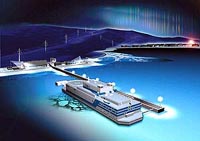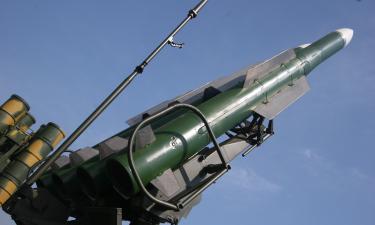Russia to build the world’s first floating nuclear power plant in 2010
Russia’s Rosenergoatom concern and Sevmashpredpriyatie shipyard based in the northern city of Severodvinsk concluded a 9 million rubles contract for building a floating nuclear power plant. The ship-makers will test the first floating nuclear power plant at the shipyard. This nuclear power plant is expected to generate cheap electricity and heat, and also to ease the energy tariffs for the enterprise. The unique project is due to be ended in autumn of 2010.

The construction of a floating nuclear power plant has been considered for the past twelve yearsin Russia. At that, it was clear from very beginning that realization of the unique project would be not more expensive than construction of an atomic submarine. And the project is to be incredibly effective as much money and efforts is spent every year in Russia’s northern and eastern territories for the northern delivery. Realization of the project was several times delayed because of money problems and ecologists’ pretensions. Ecologists gave the project their go-ahead only after the floating nuclear power plant underwent an ecological expertise.
Besides its main function, a floating station can produce thousands of cubic meters of fresh water a day to satisfy the needs of a city with the population of one million citizens. Today, countries in Africa, South-Eastern Asia and Australia suffer from shortage of fresh water. Experts state that by the year of 2015 the capacity of the water demineralization plants’ market may increase to $12 billion.
Now, Russia’s Rosatom is considering placing floating nuclear power plants in eleven regions of the Far East and the Far North where they are to cover the shortage of electric and heat energy.
Soviet Union hero, submariner Admiral Eduard Baltin says that Russia needs floating nuclear power plants, especially in hard-to-reach areas such as Chukotka and Dikson. However, he doubts that the authors of the project have designed the right variant.
In 1989, when Eduard Baltin was the first deputy commander of the Pacific Navy he got a technical statement of the floating nuclear power plant for an expertise. At that time, the admiral together with leading engineers examined almost all atomic submarines made in the country before launching. The construction of a floating nuclear power plants does not seriously differ from an atomic submarine, and that is why the man was asked to say his opinion of the idea. Baltin’s opinion of the project was negative for two reasons. The project supposes construction of a non-self-propelled floating nuclear power plant which means that a special operation must be organized involving 8-10 seagoing tugs to tug it. Plus helicopters and salvage ships. The Russian Navy will not be able to organize such an operation in the north or in the Pacific Ocean.
What is more, the project is not adapted especially for an emergency situation. As for atomic submarines, there are distinct instructions as concerning what must be done in case of emergency. A commander is obliged to sacrifice the crew lives not to allow radioactive contamination spread. If an emergency situation occurs when an atomic submarine is at its base and the vessel can operate, the commander must immediately put it out to sea to cope with the emergency situation in the open sea. It is not clear what must be done on floating nuclear power plants to cope with emergency situations in case they are non-self-propelled plants. So, the admiral is sure that the project must be changed to make floating nuclear power plants self-propelled.
It is also important to mind that these new plants are to be used in the trans-polar regions and they must be made of strong materials to stand against thick ice. The admiral fears that the project does not provide for this important peculiarity. If so, the supposed floating nuclear power plant will be really dangerous.
Because of the above-mentioned faults realization of the project was never started although shipyards in the city of Severodvinsk were ready to launch the project. Within the several years since then no amendments have been introduced into the project. The project of a floating nuclear power plant suggested for realization today is exactly the one offered years ago.
Admiral Baltin says there is a simple way to avoid the faults of the project. The atomic icebreaker Arctica stands discarded at a dock in Murmansk. The atomic icebreaker Sibir and other icebreakers will be put to docks in the future as well. Their strong hulls with huge inside rooms can be used for reequipping the icebreakers into floating nuclear power plants. Realization of the idea will require involving experienced constructors and engineers.
Trud
Translated by Maria Gousseva
Pravda.Ru
Discuss this article on Pravda.Ru English Forum
Subscribe to Pravda.Ru Telegram channel, Facebook, RSS!





